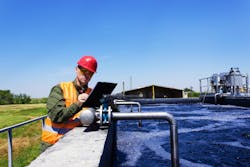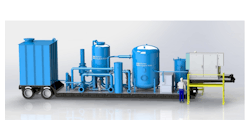Providing a sufficient water supply to residents and businesses is a growing challenge that public service providers, such as water utilities, face daily. Water is heavy and incompressible — two factors that make its reliable delivery to customers challenging and costly.
Knowing the pressure throughout the water system is a powerful tool that providers can use to help meet these challenges.
For years, the basis of automatic meter reading (AMR) and advanced metering infrastructure (AMI) systems have been to measure consumption. Today, we can use these systems to measure water pressure throughout the distribution network. Pressure measurement across the entire system can help public service providers optimize energy usage, detect and minimize leaks, improve fire service capabilities, and help make water distribution systems last.
Collecting data
It was once difficult to get pressure measurements from a distribution system. Utilities needed data in areas of the system that had no power, a difficult and costly endeavor. Without power they often used remote chart recorders and data loggers which are challenging to maintain and do not provide real-time data.
Another option for utilities is to install limited pressure-sensing devices with communication capabilities at locations with power by using existing supervisory control and data acquisition (SCADA) systems. SCADA pressure devices are most often deployed at pumping stations where water enters the system, such as a wellhead, or where it is lifted or distributed, such as a water tower. Knowing the pressure at these locations is important, but it gives you little information about the performance of the whole system.
Many emerging technologies are available for utilities to measure pressure, such as battery-powered monitoring technology. The technology is cost-effective and scalable, requiring no external power or additional infrastructure. With these battery-powered system monitoring devices, utilities can retrieve pressure data from any location within their water distribution systems in a timely and cost-efficient manner.
Once installed in the distribution system, the technology allows utilities to remotely retrieve data on water pressure. By combining this data with flow and volumetric data from the AMI system, utilities can monitor water pressure and leaks in areas of their networks that were once only accessible by sending out professional crews.
This type of monitoring gives the utility better control of the system by pinpointing where pressure issues are within the network and what activity is occurring. Beyond the distribution system, residential water meters are another option utilities use to measure water pressure and flow. These devices take the place of traditional meters and, in addition to metrological data, provide information on pressure at key locations. Since pressure and flow capability are key metrics, utilities use these new residential meters to obtain data that show a much better picture of what is happening in the system. This critical information tells the utility where pressure issues exist in the network, which, in turn, can be used to optimize the system.
Combining SCADA, battery-powered system monitoring and pressure-enabled residential water meters allows public service providers to leverage multiple applications, including pressure and leak measurement, to increase operational efficiency. Through detailed and timely readings provided by pressure measurement technology, utilities can track pressure, reduce leaks and conserve maintenance and energy costs.
Improving the system
Distributed pressure measurement should be part of a utility’s toolkit for conserving water, energy and revenue while providing a safe supply of water. With pressure measurement and adjustments to pumping operations, utilities can reduce energy costs. They can also decrease the pumping cycles and speed to optimize energy use while still providing reliable and safe delivery of the water.
By pairing pressure data with meter consumption data, utilities can better detect the presence of leaks. As the metered consumption is reduced over a short interval and pumping power and tank levels are identified, the lack of a corresponding rise in pressure is a likely indicator of a leak within the system. Once a leak is identified, the utility can also use pressure management to reduce the losses in that area until a repair can be performed.
A critical purpose of all public water systems is the supply of water for fire services. The pressure of a water main or fire service line is paramount to the performance of the system and public safety. Firefighters depend on this reliable and stable water supply in emergency situations. Knowing and managing the status of the system, especially during emergencies or disasters, can be crucial to managing these events safely and effectively.
Pressure management also helps utilities avoid potentially disastrous and costly issues in their systems. Pressure surges and over-pressurization are frequent causes to water line bursts and connection failures. By monitoring pressure, the frequency of these events can be reduced to provide new insight into increasing the longevity of the assets of the water distribution system.
Additionally, water pressure is a key component in the function and performance of jet mixing in storage tanks. Monitoring the pressure assures utilities that the pressure aspects of the mixing operations are adequate and the important water quality parameters, such as water age and stratification, are maintained.
Ensuring success
Pressure changes constantly, so real-time data is critical for capturing all the benefits of pressure management. Due to the changes in daily usage and operations, zone operations and multiple water sources, it is also important to trend the data and provide mapping capabilities of the system.
As with any data system, the ability to capture more data points across the entire network and to correlate it with other data, such as consumption, enhances the ability to optimize the system. The more points at which pressure is measured, the better utilities can understand the impact of pump changes to all branches and regions.
Satisfying the water requirements and the customers
Historically, public service providers have used AMR and AMI systems to measure consumption. Today, providers use the same systems to measure water pressure throughout their distribution networks.
Providing a sufficient and safe water supply to residents and businesses is every water utility’s goal. To meet this goal, utilities must ensure they operate efficiently and meet customers’ needs by measuring pressure to make distribution more efficient.
Every city and small town requires a reliable water supply source that meets the needs of its residents and businesses. Utilities are that trusted source. Pressure measurement helps them optimize energy usage, detect and minimize leaks, improve fire service capabilities, improve asset longevity, and optimize water age.
Photo courtesy of Sensus
Dan Pinney is the global director of water marketing for Sensus, a leading clean technology solutions company offering smart meters, communication systems, data analytics software and services for electric, gas and water industries. Pinney has more than 20 years of experience with Sensus in the global water industry with leadership roles in operations and development. He attended the University of Florida, majoring in electrical engineering. He may be reached at [email protected].



